Click on the little pictures to enlarge them.
|
Situated in a valley between the Andes and a coastal range of
hills, Santiago tends to accumulate
smog in the absence of rain or wind. It's not bad enough to notice much in the city, but
when you get a view from a hill (this is from San Cristóbal, a hill on
the edge of Santiago) you can see it. |
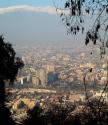
|
|
Santiago is a pleasant, modern city. The heart of the old town is the Plaza de Armas,
in front of the cathedral. |
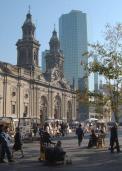
|
|
The Plaza contains heroic statues of historic figures, but also this modern sculpture.
|
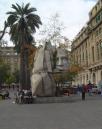
|
|
Near the Plaza is a pleasant pedestrian precinct, with street vendors and pavement cafes.
|
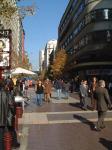
|
|
This park is on a little hill, the Cerro Santa Lucia, near the city centre.
|

|
|
In the nineteenth century Chile became a wealthy country, because of its exports of nitrates and its port, Valparaíso. The Stock Exchange building ("Bolsa de Comercio") reflects those days.
|
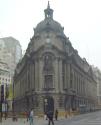
|
|
A picturesque old church not far from the Plaza de Armas.
|
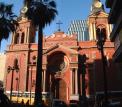
|
|
Santiago's fine-arts museum.
|

|
|
The museum contains mainly works by Chilean artists, not only paintings but also sculptures.
This fine statue of Echo is by Rebecca Matte (1875-1929).
|

|
|
You would expect Chile to have good seafood, and you would not be disappointed. Santiago's
retail seafood market is one of the best in the world; we saw shellfish there which neither
of us have seen anywhere else, including this "picoroco" (a kind of large deep-water
barnacle). The meat inside is roughly cone-shaped, between 3cm and 4cm across at
the base, and 3cm to 4cm high. The taste is very good, somewhat like crab.
|

|
|
Valparaíso. This used to be an important international port, in the days
before the Panama Canal came into use, when all shipping from the Atlantic to the west
coast of the United States had to go round Cape Horn and up the coast of Chile.
It now has a run-down air. Valparaíso is at about latitude 33 S, corresponding
to about San Diego, California in the northern hemisphere (about 33 N), but it
has a cooler climate because the cold current up the Chilean coast is colder
than the cold current down the California coast - more like San Francisco
than San Diego.
|
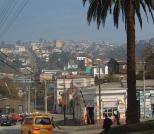
|
|
Vina del Mar, the beach resort nearest to Santiago, just north of Valparaíso. Early
afternoon, but the fog is rolling in - very like the coast near San Francisco.
|

|
|
La Serena. La Serena is a small town about 400km north of Santiago,
on the coast. It's warmer and drier than Valparaíso, but still has mild summers -
maximum summer temperature about 26°C. This is its town square.
|
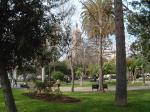
|
|
The unusual tower of La Serena's cathedral, built in about 1840.
|
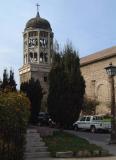
|
|
The beach at La Serena is on a bay, to the south of which is the port of Coquimbo. The
rubbish you see on the beach is almost 100% natural rubbish - bird feathers, seaweed,
bits of shell, and so forth. No, I don't know what that bird with the long neck is.
The beach is a few km long, and there were about three people on it apart from ourselves.
It's midwinter, but warm enough (about 18°) for us to have lunch at an open-air
restaurant on the beach. Good seafood, too ...
|

|
|
North of La Serena. We drove a few km north along the coast from La Serena,
just to see what's there. This is one of the best climates on earth - dry
but not arid, 17° in midwinter, never more than 26° in summer,
scenic coastline ... in a fairly safe, law-abiding country with no
serious social problems ... a twenty-minute drive from an airport which
can take jets (737s) - and nobody lives there.
|

|
|
North of La Serena. More of the same.
|

|
|
The Elqui Valley. The river Elqui flows from the Andes to the sea at La Serena.
Its valley is sparsely populated, but fertile, with farms growing grapes,
avocados, and citrus fruits, and some grazing.
|
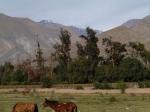
|
|
Vicuña. There's a bus service in the Elqui valley between La Serena and
Vicuña, a small farming town. This is its town square.
|
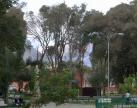
|



















